3.6.4.12 OLED C Click Board Example on SAM E51 Curiosity Nano Evaluation Kit
Description
This example demonstrates the display capability of OLED C Click board on SAM E51 Curiosity Nano Evaluation Kit.
Modules/Technology Used
- Peripheral Modules:
- GPIO
- SERCOM (SPI)
- Core
- SPI Driver
- Legato graphics
- LE external controller
- LE SPI 4-line display driver
- Timer system service
- GFX core
- TC0
- Input system service
- Systick
Hardware Used
Software/Tools Used
This project has been verified to work with the following versions of software tools:
Refer Project Manifest present in harmony-manifest-success.yml under the project folder firmware/src/config/sam_e51_cnano.
- Refer the Release Notes to know the MPLAB X IDE and MCC Plugin version.
- Any Serial Terminal application, such as Tera Term terminal application.
Because Microchip regularly updates tools, occasionally issue(s) could be discovered while using the newer versions of the tools. If the project does not seem to work and version incompatibility is suspected. It is recommended to double-check and use the same versions that the project was tested with. To download original version of MPLAB Harmony v3 packages, refer to document How to Use the MPLAB Harmony v3 Project Manifest Feature (DS90003305).
Setup
- Connect the SAM E51 Curiosity Nano Evaluation Kit to the Host PC as a USB Device through a Type-A male to micro-B USB cable connected to Micro-B USB (Debug USB) port.
- Mount the OLED C Click board on
mikroBUS connector 1 of Curiosity Nano Base.
Programming Hex File
The pre-built hex file can be programmed by following the below steps.
- Open MPLAB X IDE.
- Close all existing projects in IDE, if any project is opened.
- Go to File -> Import -> Hex/ELF File.
- In the Import Image File
window,
- Create Prebuilt Project,
- Click the Browse button to select the prebuilt hex file.
- Select Device as ATSAME51J20A.
- Ensure the proper tool is selected under Hardware Tool and click on Next button.
- Select Project Name and Folder,
- Select appropriate project name and folder and click on Finish button
- Create Prebuilt Project,
- In MPLAB X IDE, click on Make and Program Device button to program the device.
- Follow the steps in Running the Demo section below.
Programming/Debugging Application Project
- Open the project (oled_c/firmware/sam_e51_cnano.X) in MPLAB X IDE
- Ensure SAM E51 Curiosity Nano is selected as hardware tool to program/debug the application
- Build the code and program the device by clicking on the Make and Program button in MPLAB X IDE tool bar
- Follow the steps in Running the Demo section below
Running the Demo
- After power up, when the demo is
running, The OLED C Click display shows as below.

Instructions to Add OLED C Click Display Functionality to the Application
The MPLAB Harmony v3 supports adding custom display to the application using Legato (LE) External Display Controller drivers. The LE External Controller driver allows user to configure custom commands necessary for the external display.
Below are Harmony configuration for the OLED C Click.
- Connect the display components as shown
in the below figure.
- Change Configuration of components as
shown in the below figures.
Figure 3-39. SERCOM Configuration 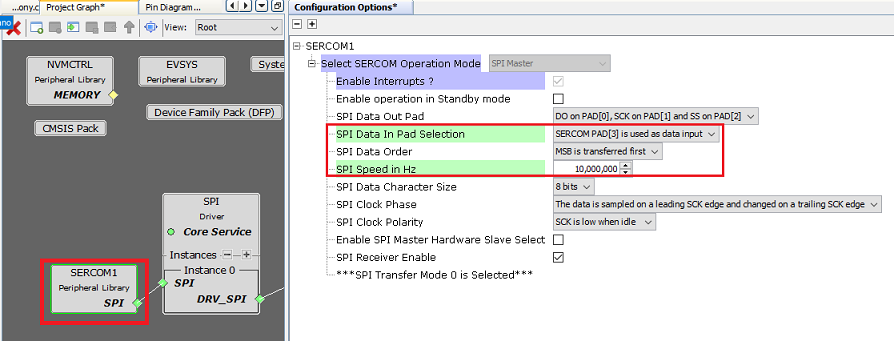
Figure 3-40. LE External configuration Note: Other component´s configurations will be default. - Change the width and height settings to
96 x 96 in GFX core LE block.
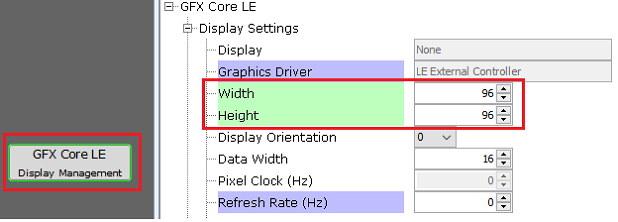
- Enable timer system service and core service as needed by the LE External Controller
driver.
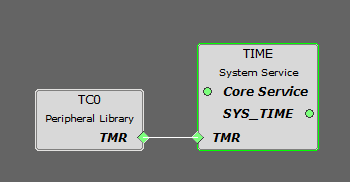
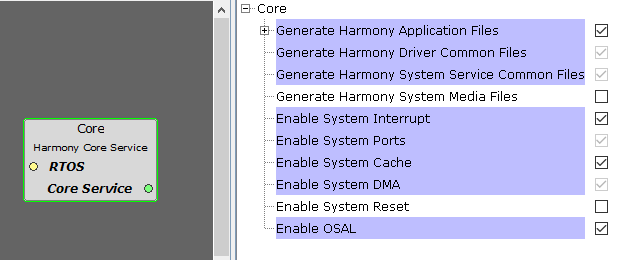 Note: Configuration for TIME System service, Harmony core service and TC0 remains default.
Note: Configuration for TIME System service, Harmony core service and TC0 remains default. - Design graphics using MPLAB Harmony
Legato Graphics Composer. Launch it using Project Graph > Plugins > Legato
Graphics Composer.
- Use Object Editor to edit the
configuration for Input Widgets and Dispaly Widgets.
- The user could use this demonstration
as an example to add OLED C Click functionality to the MPLAB Harmony v3 based
application. Follow the below steps.Note: This demonstration uses a Text Field Input widget and an Image Display widget. Therefore the configurations in the Legato Graphics Composer (shown above) routines and examples (in oled_c.c and oled_c_example.c) are based on these widgets. Users can configure and use other widgets and objects supported under Legato Graphics Composer by using this demonstration as a reference.
- If the user has not downloaded the OLED C Click demo yet Click Here to download, otherwise go to next step.
- Unzip the downloaded .zip file.
- From the unzipped folder oled_c/firmware/src, copy the folder click_routines to the folder firmware/src under the MPLAB Harmony v3 application project.
- Open MPLAB X IDE.
- Open the application project.
- In the project explorer, right
click on folder Header Files and add a sub folder click_routines by
selecting Add Existing Items from Folders...
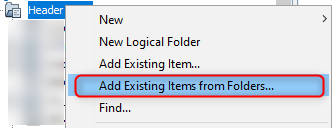
- Click on Add Folder... button.

- Select the click_routines folder and select Files of Types as Header
Files.

- Click on Add button to add the selected folder
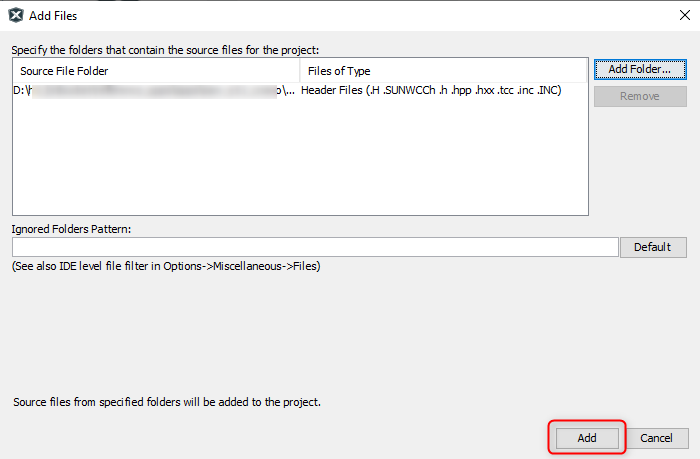
- The OLED C lick header files gets added to the project.
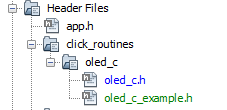
- In the project explorer, Right click on folder Source Files and add a sub
folder click_routines by selecting Add Existing Items from
Folders...
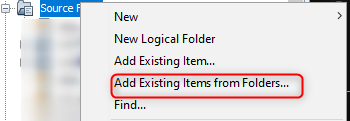
- Click on Add Folder... button.

- Select the click_routines folder and select Files of Types as Source
Files.
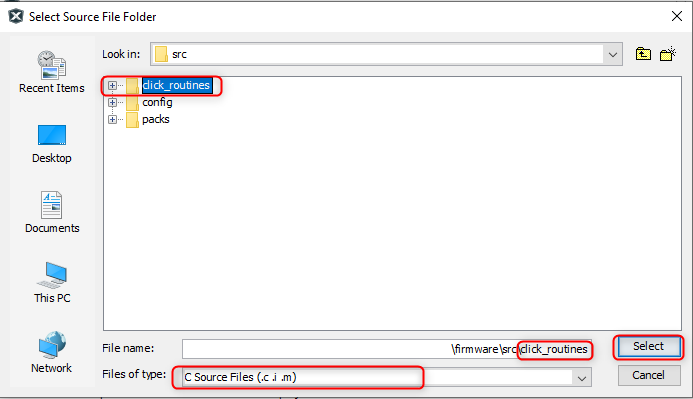
- Click on Add button to add the selected folder.
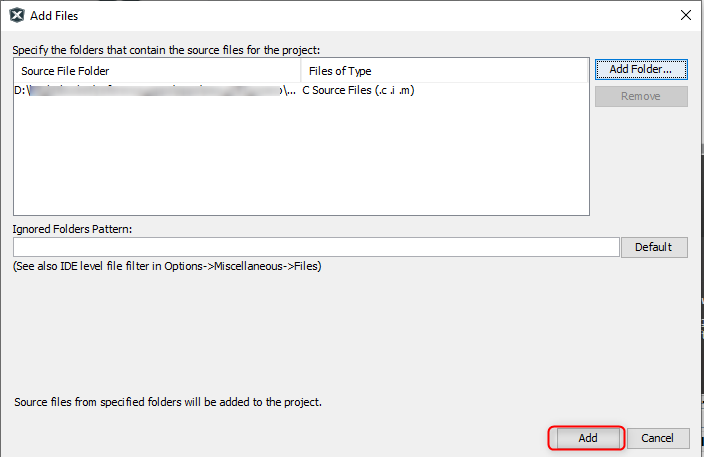
- The OLED C Click source files gets added to the project.
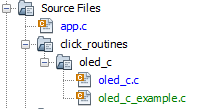
The click_routines folder contain an example C source file oled_c_example.c. The user could use oled_c_example.c as a reference to add OLED C display functionality to the application.
Comments
- Reference Training Module:
- This application demo builds and
works out of box by following the instructions above in Running the Demo
section. If the user needs to enhance/customize this application demo, should use the
MPLAB Harmony v3 Software framework. Refer links below to setup and build the
applications using MPLAB Harmony.
- How to Setup MPLAB Harmony v3 Software Development Framework (DS90003232).
- How to Build an Application by Adding a New PLIB, Driver, or Middleware to an Existing MPLAB Harmony v3 Project (DS90003253).
- MPLAB Harmony v3 is configurable through MPLAB Code Configurator (MCC). Refer to the below links for specific instructions to use MPLAB Harmony v3 with MCC.
